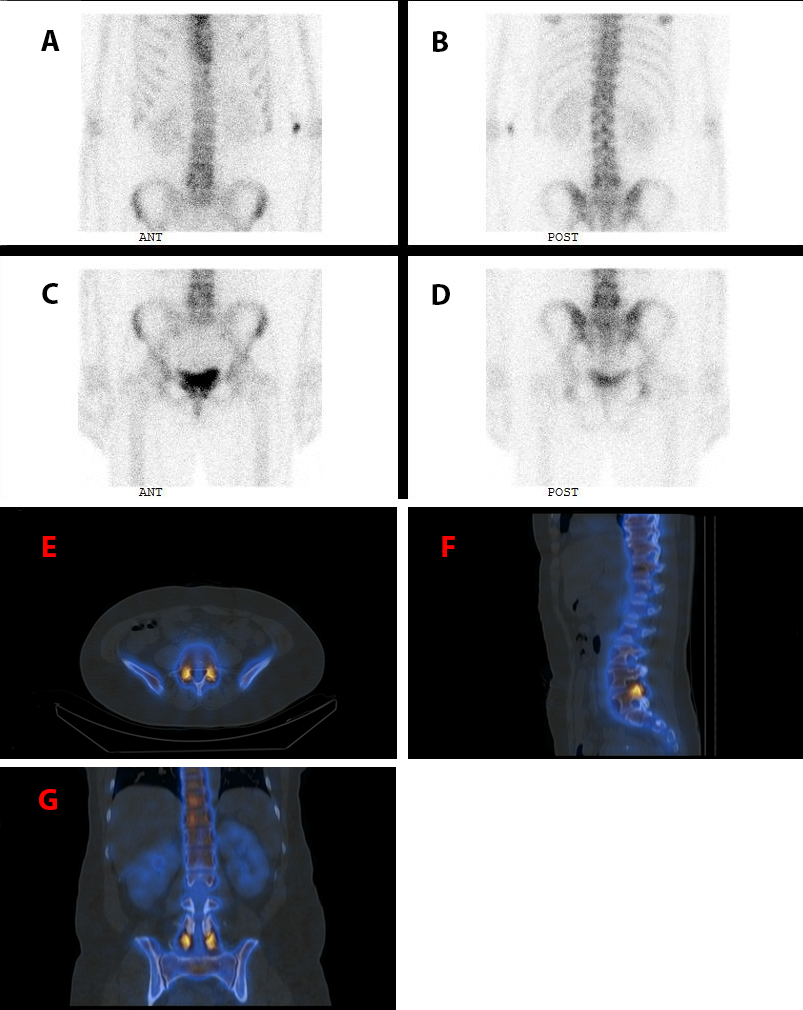TOLL FREE:
1-866-611-2665

Home WHAT IS NUCLEAR MEDICINE IMAGING?
Nuclear medicine imaging uses small amounts of radioactive materials, also called radiopharmaceuticals, to look at specific organs to see if they are functioning properly. After the radiopharmaceutical is given, it goes to the specific organ to be examined. A device called a gamma camera detects the location of the radiopharmaceutical and provides information about the specific organ’s function.
There are many instances in which nuclear medicine imaging might be appropriate to investigate a particular concern. Below are two examples of fictitious patients who illustrate two common patient pathways.
Anna suffers from chronic back pain and her doctor is considering pain management injections to alleviate her symptoms. It’s difficult for her physician to pinpoint the location of her back pain, but the presumptive diagnosis is that it’s coming from the facet joints in Anna’s lower back (lumbar spine). In this case, a nuclear medicine bone scan study can be used to help localize potential sites for an injection.
Anna’s doctor faxes a requisition to Mayfair Diagnosis requesting that Anna be booked for a pain management injection and a bone scan with SPECT/CT. A Mayfair booking agent contacts Anna to confirm the details of her appointments, including a reminder that the bone scan is a two-part appointment. She also confirms that Anna is not pregnant and not currently breastfeeding.
Part one of Anna’s bone scan with SPECT/CT appointment 8:30 a.m.:
Part two of Anna’s bone scan with SPECT/CT appointment 11:30 a.m.:
The SPECT/CT images are analyzed by a nuclear medicine physician and an area of activity on the scan is identified that could be a cause of her back pain. This finding is relayed back to the referring physician, who agrees it could be a site of her back pain. A pain management injection is then planned at this location.
Figure 1: An area of activity (yellow, boxes E, F, and G) in the lumbar spine facet joint that may be a cause of Anna’s back pain. This is an example of a bone scan SPECT/CT study.

After speaking with her doctor, Anna books a pain management appointment for her back injection.
Jeff’s doctor refers him for myocardial perfusion imaging (MPI) study to determine if his heart could be a cause of his chest pain.
A requisition with a resting electrocardiogram (ECG) result and recent blood work are sent to Mayfair Diagnostics. The booking team then contacts Jeff with details on the date and time for his exam and how to prepare for the two-day procedure. He is also told to come with a small sandwich for a snack on the first appointment day.
Jeff’s appointment day 1 – Tuesday, 2 p.m.:
Jeff’s appointment day 2 – Wednesday, 9 a.m.:
Within a few days, Jeff’s doctor receives the following information:
In the end, Jeff’s results all come back normal, which is reassuring for him and his physician because it suggests blood flow to his heart muscle is not a cause of his chest pain.
Figure 2: Jeff’s normal MPI study.

Figure 3: Example of an abnormal MPI study.

For more information about nuclear medicine imaging, please visit our services page or speak with your health care practitioner.
Our Refresh newsletter delivers the latest medical news, expert insights, and practical tips straight to your inbox, empowering you with knowledge to enhance patient care and stay informed.
By subscribing to our newsletter you understand and accept that we may share your information with vendors or other third parties who perform services on our behalf. The personal information collected may be stored, processed, and transferred to a country or region outside of Quebec.
Please read our privacy policy for more details.
| Cookie | Duration | Description |
|---|---|---|
| cookielawinfo-checkbox-analytics | 11 months | This cookie is set by GDPR Cookie Consent plugin. The cookie is used to store the user consent for the cookies in the category "Analytics". |
| cookielawinfo-checkbox-functional | 11 months | The cookie is set by GDPR cookie consent to record the user consent for the cookies in the category "Functional". |
| cookielawinfo-checkbox-necessary | 11 months | This cookie is set by GDPR Cookie Consent plugin. The cookies is used to store the user consent for the cookies in the category "Necessary". |
| cookielawinfo-checkbox-others | 11 months | This cookie is set by GDPR Cookie Consent plugin. The cookie is used to store the user consent for the cookies in the category "Other. |
| cookielawinfo-checkbox-performance | 11 months | This cookie is set by GDPR Cookie Consent plugin. The cookie is used to store the user consent for the cookies in the category "Performance". |
| viewed_cookie_policy | 11 months | The cookie is set by the GDPR Cookie Consent plugin and is used to store whether or not user has consented to the use of cookies. It does not store any personal data. |